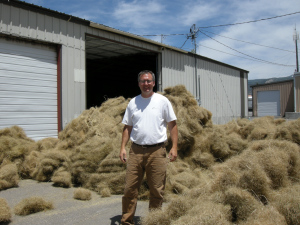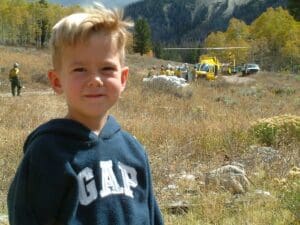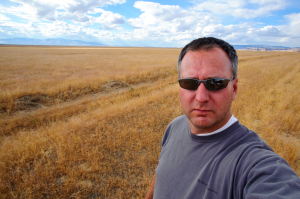a proud heritage
Our History
Great Basin Seed has a proud heritage in the Intermountain West seed industry. Our family lineage and business heritage are directly linked to the beginnings of reclamation, revegetation and wildlife habitat improvement.
WHAT IS THE GREAT BASIN?
You've probably heard of geographic areas like the Great Plains and the Rocky Mountains - but have you heard of the Great Basin? Do you know what it is? Click the link below to learn more!

Celebrating 50 Years of Great Basin Seed
Celebrating 50 Years of Great Basin Seed
To commemorate our 50 anniversary we are releasing a mini series highlighting the history of seed in the west and our beginnings.
50 Years of Great Basin Seed - Ep. 1: A Need for Seed
50 Years of Great Basin Seed - Ep. 1: A Need for Seed
Episode 1 is the story of early European immigration and the beginning of the Great Basin Experiment Station, and the effect they had on the development of reclamation, restoration, ecology, plant science and the seed industry in the West.
Episode 2 of 10: A Bag of Seed & A Dream
Episode 2 of 10: A Bag of Seed & A Dream
The story of founder Lloyd Stevens and the early years of Great Basin Seed.
Episode 3 of 10: The CRP Days
Episode 3 of 10: The CRP Days
The story of Great Basin Seed in the early 1980’s and the influence of the Natural Resources Conservation Reserve Program (“CRP”)in our formative years.
Episode 4 of 10: Jason's Story
Episode 4 of 10: Jason's Story
Jason shares his story about starting his career at Great Basin Seed and the changes he has seen since the 1990s.
50 Years of Great Basin Seed - Ep. 5: Zeke, Heidi, & The Wildfire Years
50 Years of Great Basin Seed - Ep. 5: Zeke, Heidi, & The Wildfire Years
Zeke & Heidi share their beginnings in the seed business, and we talk about big drought & fire years.
Episode 6 of 10: The Birth of Great Basin Seed Website
Episode 6 of 10: The Birth of Great Basin Seed Website
n 2004, the first Great Basin Seed website was launched. In this months episode, owners Zeke & Jason and founder Lloyd tell the story the website's its conception, growth, and journey to becoming an integral part of Great Basin Seed.
Episode 7 of 10: Ky Banta
Episode 7 of 10: Ky Banta
Ky Banta, the operations manager at Great Basin Seed, has been with us for 20 years. This episode covers his story and how his position at Great Basin Seed has evolved over the last two decades.
Episode 8 of 10: New Real Estate
Episode 8 of 10: New Real Estate
In the twenty-teens, we were out of space at our original location. Jason, Heidi, and Zeke purchased the business and began to expand!
Episode 9 of 10: Building the Processing Plant
Episode 9 of 10: Building the Processing Plant
Jason walks us through the construction of our state-of-the-art conditioning plant and more additions to the second location at Great Basin Seed.
Episode 10 of 10: Our Growing Team & The Future
Episode 10 of 10: Our Growing Team & The Future
With new infrastructure and growth, the team at Great Basin Seed needed to grow. We hope to continue to expand and serve all of you! Thanks for a historic and fantastic 50 years!
Immigration - Early 1900
Considerable damage was done to the natural resources of the Intermountain West in the late 1800's and early 1900's. Overgrazing, timber removal, new roads contributed to erosion and de-stabilization of regional ecosystems. Rainwater and runoff were no longer held back by root systems, plant matter and understory resulting in widespread, severe flash-flooding. The small towns established along the seasonal creeks of the arid Great Basin were hit with devastating floods year after year. The small settlements of Sanpete county, UT were hit particularly hard.
Right: The town of Manti in central Utah had severe flooding and catastrophic infrastructure damage in a serious of floods in the late 1800’s and early 1900’s. It lost many homes and it’s city center at least twice and severely flooded as many as six times in twenty years. Determining the root cause of the floods and addressing the problem was chief among the reasons for the establishment of the Great Basin Experiment Station.


1900-1920's
The flooding and damage of the early 1900's led in part to the establishment of the Great Basin Experimental Range. The phenomenon had to be studied and addressed to save the crumbling ecosystem and restore balance.
A network of ranger stations, complexes, laboratories, outbuildings, test plots and study sites were built across the west. The epicenter of the project was the Great Basin Experiment Station constructed in Ephraim Canyon in 1912. It was a small mountain village of living quarters, laboratories, gaging stations and research areas with a secondary "Alpine Station" near the top of Ephraim Canyon and a third in western Utahs arid Pine Valley at the foot of the Wah Wah mountains.
Left: The Great Basin Experiment Station in Ephraim Canyon is a few minutes drive from Great Basin Seed. Photo circa 1940
1920's - 1940's
In 1933 President Franklin D. Roosevelt signed an executive order that established the Civilian Conservation Corps. The CCC gave employment to thousands of people in an effort to combat the high unemployment rates of the Great Depression.
The reach and scope of the Great Basin Experiment Station expanded considerably during these years. Bolstered by the workforce and capabilities of the CCC, the range and reclamation efforts of the Great Basin Experiment Station expanded to include small stations and remote experimental field sites. They were built all across the west. Environmental and conservations efforts went into effect and they built wildlife refuges, fish hatcheries and water storage basins.
Upper Right: The Laboratory building at the Ephraim canyon Great Basin Experiment Station near completion, 1914. The Ephraim Station would grow to include over a dozen structures, including bunk houses, a kitchen and mess-hall, gathering places, and amphitheater and lout-buildings.
Lower Right: CCC workers constructing the Head House at the Ephraim canyon Great Basin Experiment Station, summer 1933.



1940's - 1960's
In the mid 1960's scientists and wildlife biologists like Richard Stevens, A. Perry Plummer, Durant McArthur, Steve Monson and many others continued the work of the Experiment Station. They are considered by many to be Godfathers of natural resource management in the Intermountain West. They literally wrote the book on range reclamation and pioneered the practices that form the foundation of the seed industry. They spent their careers researching, testing and experimenting all over the world. Their publications literally fill libraries. They pioneered courses of study that are still taught and form the backbone of graduate programs. They traveled the world and selected species for increase that would help improve disturbed lands. Cultivars released by them include 'Appar' Lewis Flax, 'Cedar' Palmer Penstemon, 'Rincon' Fourwing Saltbrush, 'Hatch' Winterfat, 'Hobble Creek' Mountain Big Sagebrush, 'Immigrant' Forage Kochia, 'Ephraim' Crested Wheatgrass and 'Paiute' Orchardgrass.
Left: The Great Basin Experiment Station in Ephraim Canyon is a few minutes drive from Great Basin Seed. Photo circa 1940
Their publications literally fill libraries.
As the scope and size of the research at the Experiment Station grew, the need arose for specific seed and plant collections. Research plots were needed, and they needed seed to grow them. As the need increased, so did the demand for collections. Lloyd Stevens ventured out to make seed collections for the projects. As research progressed and the scale of reclamation projects grew it became clear that a legitimate industry was being created. Small-time collectors were now procuring sizable contracts for seed collection. As the need grew, so did the complexity of the collections, processing, cleaning and preparing of seed for use in large-scale projects. The machinery and facilities being used to keep up with the demand were literally being invented as the process evolved.

It was during this golden age that Lloyd Stevens incorporated The Maple Leaf Company in 1974. His after-school for-pocket-change project was now a business capable of sustaining families. He acquired contracts to supply the mining industry with seed. He contracted with out-of-state growers to produce grasses and forbs. Collection efforts became broader in scope, larger in scale and farther from home.
In the early 1980’s the Conservation Reserve Program (“CRP”) gained momentum and farmers and ranchers started planting large quantities of rangeland species. In 1985 the Farm Bill “officially” legislated the CRP and it is still in force today. As mining and gas exploration grew so did the need for seed. Roads and freeways required seed. The Maple Leaf Company became a major seed supplier to all of them. In busy seasons work was performed until late hours under flood lights. Mixing seed was a whole-family affair. Seed was often transported to remote airstrips then flown-on as fast as it could be mixed.
In the 1990’s, wide-spread drought, the proliferation of cheet-grass and decades of fire-supression doctrine ended in a literal fire-storm across the Great Basin. Restoration and wildlife habitat projects were put in place to combat the effects. The complexity and size of large-scale projects led to a maturing of the seed industry and niche markets.
In 1997 Lloyds son Jason graduated from Utah State University and returned to Ephraim to take a place in the family business. He introduced computer skills, graphic design and new ideas to the company. Old mechanical systems were replaced with modern, computerized machines, ventilation systems and modern production lines. The World Wide Web was in it’s very infancy in these years. In 2004 Jason built a website during the height of online growth. It allowed the company to connect with a larger audience and serve people in a way not possible through traditional sales.

Noah Stevens (4 yo) near the heli-pad on a post-fire seeding, Wasatch Plateau, UT
In 2014 Lloyd Stevens retired and sold the company to his children Jason, Eric and Heidi. Maple Leaf Company and Great Basin Seed merged efforts – one serving wholesale in government sales, the other serving the public through online sales. 2024 is our 50th anniversary. We are still a family run business. We do not answer to corporate investors or stockholders. We are not driven by the ambitions of pushy salesmen who work for commission. We are not shadow-operated by a group of disconnected shareholders. Great Basin Seed is a handful of family members and loyal employees who care deeply about their customers and the ecosystems we all share.
 Jason in a 200 square mile patch of cheatgrass, Izzenhood, NV
Jason in a 200 square mile patch of cheatgrass, Izzenhood, NV
Great Basin Seed
450 South 50 East
Ephraim, UT 84627
435.283.1411 (Office)
435.283.6872 (Fax)
Learn more about the history of Range and Watershed Research and the Great Basin

We have compiled a small library of photos and documents below about the history of range and watershed research and reclamation in the Great Basin



Great Basin Station
Great Basin Station - Sixty Years of Progress in Range and Watershed Research by Wendell M. Keck. A 56 page history of the Great Basin Station.
From the Abstract: “Narrates briefly the history of the Great Basin Experimental Range from its establishment in 1912 as the Utah Experiment Station. Describes key problems in management of watershed and rangelands and the experiments devised to solve them, and indicates how results of this research have been applied in practice.”
Field Notes
Field notes from a "Natural Revegetation" project, 1940
The document at right is a hand-drawn field map that plots the location of plant species listed at the bottom. Note the impeccable penmanship. Alpine C.C. Pasture, August 15, 1940
The plant key uses the first letter of the genus name and the first two letters of the species. Thus, “Gilia aggregata” becomes “Gag”. This practice was later modified to use the first two letters of both genus and species and put into widespread use. We continue to use it at Great Basin Seed as a simple but effective way to inventory seed and label. Example: “Penstemon palmeri” becomes “PEPA”.



Beginnings of Range Management
Beginnings of Range Management – An Anthology of the Sampson-Ellison Photo Plots. An 86 page technical report and short history of the Great Basin Experiment Station by David A. Prevedel, E. Durant McArthur and Curtis M. Johnson
From the Abstract: “High-elevation watersheds on the Wasatch Plateau in central Utah were severely overgrazed in the late 1800s, resulting in catastrophic flooding and mudflows through adjacent communities. Affected citizens petitioned the Federal government to establish a Forest Reserve (1902), and the Manti National Forest was established by the Transfer Act of 1905. The Great Basin Station, a forerunner of the Intermountain Forest and Range Experiment Station, was created in 1911 within this area to study the influence of rangeland vegetation on erosion and floods”.
Building a Research Legacy
The Intermountain Station 1911-1997 by Richard J. Klade
From the Abstract: “Includes highlights of the history of organizations that preceded formation of the Intermountain Forest and Range Experiment Station in 1954. Provides detailed accounts of Intermountain Station research and administrative accomplishments, some of the people who led activities, and changes in the organization from 1954 through 1997 when the Intermountain and Rocky Mountain Stations merged to become the Rocky Mountain Research Station. Many significant Station publications are indicated by title in the text, and the references list includes other publications that provide additional historic background on research programs and results”.
“.



